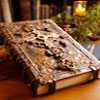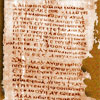Is The Bible The Word Of God?
 by Erich von Daniken
by Erich von Daniken
More than a hundred thousand million people in this world call themselves Christians. What is it that ties them to their creed? A common basis is necessary for the purpose. That basis was and is the Bible.
The word Bible comes from the Greek: ta hiblia. books. Under the entry ‘bible’ in the dictionary it says: ‘Book of books, Holy Scriptures, the collection of writings which are regarded by the Christian Church as documents of the divine revelation, God’s word, and as binding in faith and life …’
Against their better judgment, the churches proclaim that the Bible is ‘God’s word’.
To the ears and simple heart of the humble Christian this proclamation from the anointed tongues of theologians sounds as if God in person had inspired the Book of Books and/or dictated it, and as far as the New Testament is concerned he is left to believe that the companions of Jesus of Nazareth took down his speeches, rules of life and ‘prophecies’ in shorthand, observed his miracles at first hand and soon afterwards noted the miraculous events down in a chronicle. The Christian then is supposed to accept the Book of Books as a collection of authentic reports. Professor Hans Conzelmann, Professor of New Testament Studies, Gottingen, admitted that the Christian community really continues to exist because the conclusions of critical examinations of the Bible are largely unknown to them. That is not the proper Christian way, but it is true.
The Bible is not what it is represented to be and even the Holy Ghost is no longer what it was originally supposed to be. I know that my theological critics will raise their eyebrows and say: ‘But we know that perfectly well, you can read it in our theological literature.’
They are right. But: the churches, large and small, live among and by the public. They accompany the simple man from the cradle to the grave, at important stages of life they make themselves ‘indispensable’ by their ceremonies, they exercise their power and fill the church coffers in public. So it is quite unfair to say that all the errors (publicly diffused as the ultimate truth) of religious biblical dogma are available (and admitted) in the books of remote theological libraries. How many of the more than one hundred thousand million Christians ever cross the threshold of one of those libraries?
***
Joachim Kahl, graduate in theology of Phillips University, Marburg, states: ‘The ignorance of most Christians is largely due to the scanty information provided by theologians and ecclesiastical historians, who know two ways of concealing the scandalous facts of their books. They either twist reality into its exact opposite or conceal it.’ I call both methods cheating the faithful.
The layman has a right to be liberated from erroneous Christian dogmas that have long since been superseded; he can, since it happens in the name of the Lord, demand that he be told the truth in an intelligible way in language without complicated and impossible theological gymnastics.
In the Constitution of the Council on the Church on 21st November, 1964, in the statement of 28th November, 1965, on the relationship with non-Christian religions, as well as in the solemn credo of Pope Paul VI of 30th June, 1968, it was once more expressly laid down:
that the Catholic Church alone proclaims the infallible truth,
that the Catholic Church is necessary for salvation,
that the Catholic Church alone is the true heir of the divine promise,
that the Catholic Church alone is in possession of the spirit of Christ,
that the Catholic Church alone is entrusted with the infallible teaching office,
that the Catholic Church alone is in possession of the absolute truth.
On 18th November, 1965, the Catholic Church proclaimed solemnly and most officially in the dogmatic constitution:
that God was the originator of the Bible,
that all parts of the Bible are sacred
that all parts of the Bible were composed under the influence of the Holy Ghost,
that everything that the inspired composers of the Bible say must be considered to be written by the Holy Ghost and that what is taught in the Bible is accurate, true and without error.
So that they can defend this exclusive property to the vast community of believers, Theologists, unaffected by the results of their biblical research, base themselves on the evangelists, the epistles of the apostles and the miraculous ‘original text’ of ‘the Holy Scriptures’.
But none of the evangelists was a contemporary of Jesus and no contemporary wrote an eyewitness account. Nothing was written down about Jesus and his followers, until after the destruction of Jerusalem by the Roman Emperor Titus (A.D. 39-81) in the year 70. And if the year 30 is accepted for the death of the Son of God, then Mark, the first author of the Bible, wrote his gospel at least forty years after the crucifixion of Jesus. Dr. Johannes Lehmann, co-translator of a modern edition of the Bible, says on this point: ‘The evangelists are interpreters, not biographers; they have not illuminated what had grown dark with the passage of generations, but obscured what was still light. They have not written history, but made history. They did not want to report, but to justify.’
The ‘original text’, so frequently, consulted and so abundant in theological hairsplitting, do not exist at all. So what do we possess? Transcripts that without exception originated between the fourth and tenth centuries A.D. and these transcripts, some 1,500 of them, are transcripts of transcripts, and not a single transcript agrees with another. Over 80,000 (!) variations have been counted. There is not a single page of the ‘original texts’ without contradictions. From copy to copy the verses were understood differently by sympathetic authors and their functions transformed to suit contemporary needs.
The biblical ‘original texts’ teem with thousands and thousands of easily provable and well-known errors.
The most prominent of them is Codex Sinaiticus – written in the fourth century A.D., like the Codex Vaticanus – was found in the Sinai Convent in 1844. It contains 16,000 corrections, which are theorized to have gone back to seven correctors. Many passages were altered three times and replaced by a fourth ‘original text’. Friedrich Delitzsch, author of a Hebrew dictionary and a first-rate scholar, established about 3,000 copying mistakes in the ‘original text’.
This business of the ‘original text’ is a symptom of the sublime art of theological description. Every normal mortal connects the concept ‘original text’ with the very first version, an undisputed and indisputable document. What would the Christian layman say if he was told openly from the pulpit that an original text in this sense did not exist?
It is staggering that the fairy tale of the Bible as ‘God’s word’ has endured so long – there is no comparison in the 7,000 years of human history. But the fact that the ‘original texts,’ which teem with contradictions and falsifications, are still publicized as ‘God’s word’ borders on schizophrenia. I know that ‘falsification’ is a harsh description, for falsification means nothing more or less than being intentionally misleading. But even the Fathers of the Church of the first centuries A.D. agreed that, though they might quarrel about the culprits, the ‘original texts’ were falsified; they still spoke openly of ‘interpolations, profanation, destruction, improvement, corruption, erasing’ – but that is long ago and then as now the hair-splitting does not alter the objective fact of falsification.
Christian theologians, naturally enough, do not like to hear anyone talk about falsifications. They take the forgers under their black wings and whisper about ‘conscious alterations’, they wrap the correctors in verbal cotton wool and claim that ‘they acted in the interests of the true word of God – to which they must have had access long after Christ’.
Dr. Robert Kehl, Zurich, writes in connection with the falsifications: ‘Frequently the same passage has been “corrected” in the opposite sense by another, depending entirely on which dogmatic view had to be defended in the relevant school. At all events, a completely chaotic text and irremediable confusion has already arisen owing to individual “corrections”, but even more so to deliberate ones.’ And the priest Jean Schorrer, for many years spiritual adviser to the Cathedral of Saint-Pierre, Geneva, came to the conclusion that the theory of the total inspiration of the Bible and the idea that God was its author were untenable: this idea clashed so fiercely with the most elementary knowledge of healthy human reason and is refuted so clearly by the Bible itself, that it could only be defended by ignorant evangelists and a flock devoid of any kind of general culture.
***
In some recent editions of the Bible – for example, in the popular edition of the Zurich Bible – it is at least admitted that some passages were added by a later hand. But even this is only a very hesitant indication of the massive manipulation to which the biblical texts have been subjected. In the series Die Religion des Modernen Menschen, Dr. Robert Kehl gives a sketch of what really happened. I quote:
“Most believers in the Bible have the naive credo that the Bible has always existed in the form in which they read it today. They believe that the Bible has always contained all the sections which are found in their personal copy of the Bible. They do not know – and most of them do not want to know — that for about 200 years the first Christians had no ‘scripture’ apart from the Old Testament, and that even the Old Testament canon had not been definitely established in the days of the early Christians, that written versions of the New Testament only came into being quite slowly, that for a long time no one dreamt of considering these New Testament writings as Holy Scripture, that with the passage of time the custom arose of reading these writings to the Congregations, but that even then no one dreamt of treating them as Holy Scripture with the same status as the Old Testament, that this idea first occurred to people when the different factions in Christianity were fighting each other and they felt the need to be able to back themselves up with something binding, that in this way people only began to regard these writings as Holy Scripture about A.D. 200.”
In other words, there is nothing there about inspiration by a spirit, not even by the Holy Ghost. ‘God’s word’ sneaks in as if by a secret ballot in which black and white balls are used. Those are facts. It would be more convincing if the world organizations which claim to be guardians of the ultimate and only truth did not limit themselves to dealing with historical facts in discussions that are dialectically perfect, but unintelligible to a layman. What they should do is use a first-class public relations system to bring the facts to the ‘common people’ in generally intelligible language! Do they lack the courage of their convictions? Are they worried lest the business basis, the paid-up capital as it were, be taken away from their ‘limited company’ if it were admitted that the, Bible is not ‘God’s word’, because it cannot be so according to the proven way in which it originated?
How long are the leaders of the Church going to persist in the error that the faithful can be kept in a state of Christian humility and ingenuousness? How long do they think they can describe contradictions and falsifications as ‘willed by God’, ‘for the salvation of the faithful’ or inspired by the ‘Holy Ghost’? If that is the way facts are treated, what has theological scholarship to do with knowledge? Nevertheless theology is allotted a special faculty in the universities: it is financed by the taxpayer, who usually calls himself a Christian. I assume that straight-forward scientific knowledge is imparted to the theological students in these faculties. What kind of distortion takes place between academic teaching and what is preached from the pulpit? Where does the ‘brain-washing’ take place that caused the facts to be forgotten, and the old song of the Bible as the true word of God rung out once more from the pulpit?
***
It all began with the councils, the assemblies of senior pastors for dealing with important ecclesiastical affairs. A prerequisite for the appointment of an official of the church is that he have ‘charisma’. i.e. that he shares the ‘divine gift of grace’. Hence when councils with such illustrious members meet, the Holy Ghost is among them, omnipresent and active.
The Assemblies of the first five Ecumenical (which means the whole Catholic Church) Councils of the early Christian world set the standards for the doctrine and organization of the new religion.
The oldest dogmas, which are still valid today, were proclaimed at Nicea (A.D. 325), Constantinople (381), Ephesus (431), Chalcedon (451) and again at Constantinople (553). It is worthwhile taking a quick look at how the Councils came into being and what decisions were taken at them – presumably for all eternity.
The first Ecumenical Council took place at Nicea. The Council was convened by the Emperor Constantine (who was not crowned until he was on his deathbed, because he wanted to use the rapidly expanding Christian religion, with its great potentialities, to strengthen the Roman Empire. When Constantine picked out and convened the 318 bishops for the Council, the background was pure power politics, religious concerns taking very much of a backseat. Even the charismatic bishops can have been in no doubt about that, for not only did the Emperor preside over the Council, he also expressly proclaimed that his will was ecclesiastical law. The senior pastors accepted him as ‘Universal Bishop’, even though he was uncrowned, and let him take part in votes on church dogma as a secular prince. Ecclesiastical and earthly interests entered into an astonishing symbiosis even at that early stage!
Constantine was completely ignorant of Jesus’ teaching. He was an adherent of the solar cult of Mithras (ancient Iranian god of light), who was portrayed on coins as the ‘invincible sun’ and worshiped until far into the Christian era. When he gave his name to the old Greek commercial city of Byzantium and made Constantinople (330) the capital of the Roman Empire, he had a mighty column erected for the ceremonial opening of the metropolis, with the Emperor and the invincible sun on top of it, forgetting all about Christian humility. Clouds of incense floated in the air and candle-lit processions made their tortuous way through the streets in his honor. Far from abolishing slavery in the Christian spirit of loving one’s neighbor, the Pontifex ordered that slaves caught pilfering food should have molten lead poured down their throats and allowed parents to sell their children in times of need.
What were the ecclesiastical-cum-political decisions that this pasha had a hand in?
Until Nicea, the doctrine of Arius of Alexandria that God and Christ were not identical, but only similar, held good. Constantine forced the Council to proclaim that God the Father and Jesus were of the same essence. This absolutely vital amendment became church dogma by imperial decree. That is how Jesus became identical with God. With this as a foundation, the bishops unanimously passed the ‘Nicene Creed’.
The non-Christian Constantine did the Church another enormous service. Until that time, the place where Jesus was buried had remained unknown. Then, in the year of grace 326, the Roman Emperor, led by ‘divine inspiration’, discovered the grave of Jesus, who had just become consubstantial with God. (In 330 Constantine had the Church of the Holy Sepulchre built.) However, this wonderful discovery did not stop Constantine from murdering some of his close relatives during the same year: his son Crispus, his wife Faustina, whom he had plunged into boiling water, and his father-in-law Maximian, whom he imprisoned and forced to commit suicide.
That is the image of the Emperor and Pontifex who stage-managed the Nicene Creed and who, when the Council was over, told the Christian communities in a circular letter that the agreement of the 318 bishops was the ‘Decision of God’.
Incidentally, Constantine the Great was canonized by the Armenian, Greek, and Russian Churches.
The second Ecumenical Council was at Constantinople. This council was convened by the Emperor Theodosius I (347-395), who was flatteringly nicknamed ‘the Great’ by the Church. This Roman Emperor did not lag behind his colleague Constantine in moral qualities. He was a veritable oppressor of the poor, so history tells us, who swamped the common people with intolerable burdens, which his tax collectors exacted with brutal tortures. With the full rigour of his imperial power, he forbade anyone to give refuge to any of these downtrodden creatures who might have offended him. If they did so, he had the inhabitants of whole villages slaughtered. In the year 390 (i.e. almost ten years after the holy council) he had 7,000 rebellious citizens murdered in a frightful bloodbath in the circus of the town of Thessalonika – at the same time as the ‘Halleluya’ (Praise Yah / Yahweh) came into use in Christian churches. Theodosius proclaimed the Christian doctrine the state religion (hence ‘the Great’) and made Ambrosius, Bishop of Milan, raze all heathen sanctuaries to the ground. With his methods Theodosius could well have been the ancestor of the Inquisition. If Jesus preached a joyous message to the poor and oppressed,Theodosius was Antichrist in person. Yet this ‘Unholy Ghost’ convened the second Council at Constantinople.
What happened there?
The dogma of the Trinity of Father, Son and Holy Ghost, was introduced into church doctrine by the assembly of senior pastors known by theological experts as the Rump Council. It was turned into the ‘Niceno-Constantinopolitan Creed’. Thus – something for connoisseurs of the finer points of theology – was introduced the doctrine of the consubstantiality of Father, Son and Holy Ghost. Today the Church still feeds on the dogma of the Trinity that was added in this way.
The third Ecumenical Council at Ephesus was convened by the East Roman Emperor Theodosius II (408-450) and the West Roman Emperor Valentianus III (425-455). These two emperors did not bother their heads about secular or ecclesiastical problems: they were playboys. So they seldom graced the council with their presence.
Theodosius II was a weakling who devoted himself wholly to his hobbies and tyrannically levied taxes from his subjects to pay for his extravagant way of life. The Emperor was lavish in taking ‘what was the Emperor’s’. It is small wonder that he was completely under the influence of his power-obsessed intriguing elder sister Pulcheria (399-453). For some time she acted as regent for her brother and boasted of being a virgin (which only made her contemporaries laugh) on every suitable and unsuitable occasion. Her pious protestation sufficed to get her made a saint, though this did not stop her, after her brother’s death, from having his able and successful rival Chrysophus murdered. As for his West Roman imperial colleagues Valentianus, he was under the thumb of his mother Galla Placidia and ultimately assassinated.
What happened at Ephesus?
The Council declared, that Mary should be worshiped as the Mother of God. By inclusion in the ‘Theodosian’, Codex their decision became an imperial law. Thus one thing followed another, and the Holy Ghost was ever present …
The fourth Ecumenical Council at Chalcedon was formally convened by the Byzantine Emperor Marcianus (396-457), but in reality it was run by the virgin Pulcheria, who had married Marcianus after the death of Theodosius. She knew far better than the bishops what she wanted. The theologian Eduard Schwartz came to the conclusion that Pulcheria convened and pushed through the Council against the will of the various churches, and held the reins of the deliberations firmly in her hands.
What happened at Chalcedon?
With his Epistola dogmatica (Dogmatic Letter), Pope Leo I initiated the dogmatic formula that Jesus had two natures. The Council proclaimed the doctrine that divine and human nature are unalloyed and inseparably united in the person of Jesus. This double nature still persists today as the ‘Chalcedonian Creed’. Last, but not least, the preservation of the unity of the doctrine was entrusted to the Pope, who could intervene whenever he saw fit. That is how the primacy of Rome originated. The foundations for future developments were made official. Today the men in the Vatican must still be grateful to the unholy Pulcheria for pushing through the Council of Chalcedon with her intrigues.
The fifth Ecumenical Council was again at Constantinople. It was staged by the East Roman Emperor Justinian I (483-565). He was no mean despot, but in spite of or because of it he fell in with the whims of his wife and co-regent Theodora (497-548). This daughter of a circus attendant deserved well of her husband, because she saved the throne during the rebellion of Nika (532), when there was an uprising against the tyrannical sovereign. After this service, she was able to give her fanatical will full rein and wipe out the rest of heathendom, a project which the senior pastors of the Council warmly encouraged.
The bishops of the Fifth Council had virtually no work to do. Anything that Justinian had in mind had been achieved long before by imperial decrees and laws. It is not unironical to find this assembly described in theological literature as the ‘Council of Acclamation’.
Justinian summoned Pope Vigilius (537-555) – ‘unworthy representative of his office’, who was later quoted by opponents of papal infallibility to prove their case – to Constantinople. Vigilius and the bishops submitted themselves to the power – political interests of the Emperor, who found a place in the history books because of his pitiless laws against heretics. Henceforth a ‘heretic’ was anyone who denied the Christian dogmas. He was subject to savage punishments, and even death. An army of Roman officials tracked down dissenters, rounding them up in droves and forcing them to accept Christian baptism on Justinian’s orders.
The Byzantine historian Procopius (circa 490-555) was author of a History of Justinian’s Wars against the Persians, Vandals and Goths, and a book about Justinian’s buildings (Hagia Sophia!), but he also wrote a pamphlet against Justinian and his wife Theodora. Procopius, who presumably knew his noble lord well, described Justinian as proud, hypocritical, unrighteous, malicious, cruel and bloodthirsty. Christian interpreters of history like to deviate from Procopius’s description. Naturally! For Justinian was canonized like the Emperors Constantine and Theodosius.
What happened at the Council?
The Greek ecclesiastical writer Origen (circa 185-254), a teacher in the catechists’ school at Alexandria, was the most important theologian in Christian antiquity and the first advocate of a critical examination of the Bible. With the help of his Platonic training he had to some extent made the scriptures intelligible and spiritualized them by allegorical interpretations. The Council condemned his deviations and said his exegeses were unorthodox. What was to be orthodox in future was exclusively determined by the leaders of the Church, inspired by the Holy Ghost. When this decision was taken by the Council, persecution was not confined to Origen’s numerous followers; the view halloo! to hunt all the other dissenters was also sounded.
(About this time the ring which bishops wear became a symbol of ‘marriage’ to the Church. A strange union, in my opinion, between man and Holy Ghost.)
The Bible is not ‘God’s word’. Moreover, the dogmas concocted (at the first five councils) by an army of princes of the church are not inspired by the Holy Ghost – in spite of the participants’ supposed charisma. This comes as a severe shock to the average religious layman, because he is usually unprepared for it.
Excerpt from The Miracles Of The Gods
Posted in Other Topics, True History of Manwith 2 comments.






Spot on Sunny.
Do you have anything on the possibility that Josephus and St Paul where the same person.
Thanks
I am not sure. Maybe someone else who might know can answer that here hopefully.
Thanks Derek